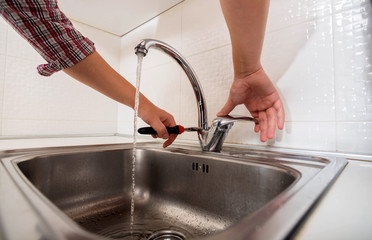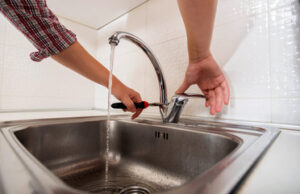
Why You Should Leave Faucet Repair to the Pros
Faucets have come a long way in design and construction in recent years. Nonetheless, even good-quality faucets can break down with normal wear and tear.
Shut off the water supply, and remove the faucet handles using a compatible screwdriver. If the handle has a decorative cap over a screw, use pliers to loosen and remove it. If you need some professional assistance, contact Plumbers Sarasota now!
A dripping faucet is annoying, wastes water, and can lead to costly flooding and damage to surrounding surfaces. Most of the time, a leaky faucet is caused by damaged or worn-out seals. Repairing these seals is often a simple task for an experienced do-it-yourselfer, but if the leak is more substantial or directly related to the plumbing underneath your sink, you should leave this type of faucet repair to professionals.
Start by shutting off the water supply to your sink. Find the water valves in the cabinet below your sink and turn them clockwise to completely shut off the flow of water. You may also want to remove any items under your sink that could get wet in the event of a drip or flood.
Once you’ve turned off the water, remove the handles from your faucet. Use a screwdriver to remove the decorative cap on the top of each handle, which will expose the screw that holds it in place. Once you’ve removed the screws, you can begin removing internal components to see what the issue is.
If the faucet is leaking from the spout, it could be due to a damaged or worn-out valve seat or a washer. The seat connects the spout to the faucet, so it is vulnerable to sediment buildup and corrosive chemicals. You’ll need to replace the valve seat and washer.
Leaks at the base of the faucet could be due to a worn-out or loose O-ring or a stem screw that is not tight enough. You can try tightening the screw, or you can replace it with a new one to resolve the problem.
If your leak is at the cartridge or ball, you can drain your faucet by using needle-nose pliers to remove the circular threaded piece (called a retainer) that sits on top of the cartridge. This will allow you to pull the cartridge out of its assembly and inspect the O-rings for wear or damage. You can then replace them or the entire cartridge. You’ll also need to remove the cam washer and inlet washer, which can be accessed by removing the cap or bonnet on the escutcheon.
Mold
Mold can grow in any damp environment, and it often forms around plumbing fixtures. It thrives in the dark, warm and moist conditions found under sinks, in toilets and at faucet aerators. Mold spores can also be carried into the air through leaky water pipes, which creates a potential health risk for people with asthma or allergies.
A few drops of mold spores can trigger these conditions, leading to symptoms like a runny nose, itchy eyes or wheezing. Larger areas of mold, however, may be toxic and require professional removal. This is particularly true of black mold, which can pose a serious health risk. If you suspect that you have a mold problem in or near your sink, contact a plumber for an inspection.
If you do have a mold issue, be sure to wear rubber gloves and protective clothing when cleaning and disposing of it. This will help prevent the spread of spores throughout your home. Additionally, make sure to keep humidity levels in your home below 40% by opening windows and using box fans to encourage airflow.
In addition to mold, a leaky faucet can lead to wood rot and other structural damage. This can increase the cost of repairing or replacing your bathroom. A plumber can check the integrity of your plumbing system and provide the right repairs to prevent further problems.
Whether you have a leaky faucet that is causing an obnoxious noise or a mildew-covered fixture that is a health hazard, these problems need to be fixed as soon as possible. The longer these issues are ignored, the worse they will get. Leaks waste water and money and can cause other types of damage to your home.
Even small leaks can add up quickly, increasing your water bill significantly. In some cases, it is more economical to replace the whole faucet than to fix a single leaky fixture. A new faucet can also save you money on your water bill by reducing water waste and lowering your monthly bills. Additionally, a new faucet can improve the aesthetics of your bathroom and give it a fresh look.
Scratches and Cracks
A dripping faucet is not just annoying but it also wastes water. It adds up to your water bill and damages the water lines in your house. Not to mention, it can cause other problems like rust and mineral deposits. This is why if you see that your faucet is leaking even when the handle is off, you should call a plumberin Katy, TX right away.
If you hear squeaky sounds every time you turn the handle of your faucet, it’s a sign that the threads at the stem are worn out. This is not a problem that needs replacement, but it still warrants repair by an experienced plumber to avoid more problems in the future.
Unusual water discharge such as bubbling may indicate a faulty aerator or diverter valve. Replacing these parts will make your faucet work properly again. Unusual water discharge accompanied by a loud sputtering sound is more alarming as it could indicate a hardened rubber washer or internal damage in your faucet.
Cracks and scratches in your sink basin are often a result of age-related wear and tear or improper installation. Often, these cracks and scratches can be repaired using an adhesive or epoxy.
Before applying any repair materials, it is recommended that you clean the cracked area with a damp cloth and allow it to dry. You can also roughen the surface by sanding it lightly to help the adhesive or epoxy adhere and create a stronger bond. Before proceeding, read the manufacturer’s instructions to know how long the filler or adhesive will take to dry and set.
If the cracks in your sink are deep, you may have to replace your entire sink to avoid further deterioration of your faucet. This can save you a lot of money and hassle in the long run.
Getting a new faucet is not a big investment, but it will definitely give you peace of mind. It can help you save up on your energy bills and it will also protect your home from rust, corrosion, and other issues caused by a poorly functioning faucet.
Brand Name
Nothing man-made lasts forever, and faucets are no exception. Even high-quality brands and designs will break down over time, and when they do, it can be frustrating to find replacement parts that are compatible with your faucet. The best way to ensure that your repair and installation job is successful is to purchase a brand-name faucet, which are made by manufacturers who stand behind their products. Keeping this information in mind when shopping for faucets will make it easier to find the right parts and avoid any surprises down the road.
Identifying the brand of your faucet can be difficult, but there are several ways to do so. The easiest and most obvious way is to look for a logo, which many manufacturers place on their faucets. This may be on the escutcheon (the plate beneath the faucet), the body of the spout, or even on the handle itself. If you can’t find a logo, you can also try searching online or visiting a local plumbing store that carries specific faucets to see if they have any information about the manufacturer.
Another option is to contact the manufacturer directly. Their customer support representatives will be able to help you narrow down the possibilities based on the design features you’ve found on your faucet. They can even request photos of your faucet from different angles so that they can better assess the identifying features and determine which models match yours.
If you can’t find the name of your faucet’s manufacturer, you can still check for a label on the cold water supply line or the user manual. Most brands will have a tag that contains the model number, and you can usually find this information underneath the sink or on the supply line itself.
Alternatively, you can use a tool that plumbers often use to identify faucet stems and handles for easy replacement: a broach gauge. This device has 18 different sized cylindrical tubes with male ends that fit inside the faucet handle or stem and female ends that fit in holes on the top of the stem. By counting the number of splines on your faucet’s stem and comparing to those on a broach gauge, you can find out which brand it belongs to.


